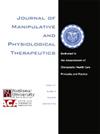光生物调节疗法对不同阶段肌营养不良表型的影响:组织形态计量学研究。
IF 1.4
4区 医学
Q4 HEALTH CARE SCIENCES & SERVICES
Journal of Manipulative and Physiological Therapeutics
Pub Date : 2024-07-01
DOI:10.1016/j.jmpt.2024.09.008
引用次数: 0
摘要
研究目的本研究的目的是评估光生物调节疗法(PBMT)对 X 连锁肌营养不良症(mdx)小鼠腓肠肌的影响:研究使用了杜氏肌营养不良症的实验模型,该模型处于肌纤维退化/再生的三个阶段:急性期(14-28 天)、急性期和稳定期(14-42 天)以及稳定期(28-42 天)。在 mdx 小鼠 14 至 28 天、14 至 42 天和 28 至 42 天时,每周对其萎缩性腓肠肌进行 3 次 0.6 焦耳的光生物调节疗法(又称低强度光疗法)。治疗期结束后,收集腓肠肌并制备冷冻切片进行组织病理学分析:结果:在所有 3 个评估阶段中,均观察到 PBMT 治疗后 mdx 小鼠腓肠肌肌纤维对免疫球蛋白 G 的摄取、炎症面积、巨噬细胞浸润、反应性二氢乙二胺面积和自发荧光脂褐质颗粒数量显著减少:结果表明,在肌肉变性/再生过程的急性期或之后使用低强度光疗法,可改善萎缩性肌肉的病理组织形态学特征。基于这些结果,低强度光疗法似乎是一种治疗肌营养不良症的有前途的疗法,值得在人体中进一步研究以验证其疗效。本文章由计算机程序翻译,如有差异,请以英文原文为准。
Photobiomodulation Therapy Effects at Different Stages of the Dystrophic Phenotype: A Histomorphometric Study
Objective
The purpose of this study was to evaluate the effects of photobiomodulation therapy (PBMT) on the gastrocnemius muscle of X-linked muscular dystrophy (mdx) mice.
Methods
The study used an experimental model of Duchenne muscular dystrophy, at 3 stages of degeneration/regeneration of muscle fibers: an acute stage (14-28 days old), acute and stabilized stages (14-42 days old), and a stabilized stage (28-42 days old). Photobiomodulation therapy (also known as low-level light therapy) at 0.6 J was applied 3 times per week to the dystrophic gastrocnemius muscle of mdx mice at ages 14 to 28, 14 to 42, and 28 to 42 days. After the treatment period, the gastrocnemius muscle was collected, and cryosections were prepared for histopathologic analysis.
Results
In all 3 stages evaluated, a significant reduction was observed in immunoglobulin G uptake by muscle fibers, the inflammatory area, macrophage infiltration, the reactive dihydroethidium area, and the number of autofluorescent lipofuscin granules in the gastrocnemius muscle of mdx mice after PBMT.
Conclusion
The results demonstrated that low-level light therapy, when applied during or after the acute phase of the degeneration/regeneration muscle process, improves the pathological histomorphologic features in dystrophic muscle. Based on these results, PBMT appears to be a promising therapy for dystrophinopathies, warranting further research in humans to verify its efficacy.
求助全文
通过发布文献求助,成功后即可免费获取论文全文。
去求助
来源期刊
CiteScore
3.00
自引率
7.70%
发文量
63
审稿时长
29 weeks
期刊介绍:
The Journal of Manipulative and Physiological Therapeutics (JMPT) is an international and interdisciplinary journal dedicated to the advancement of conservative health care principles and practices. The JMPT is the premier biomedical publication in the chiropractic profession and publishes peer reviewed, research articles and the Journal''s editorial board includes leading researchers from around the world.
The Journal publishes original primary research and review articles of the highest quality in relevant topic areas. The JMPT addresses practitioners and researchers needs by adding to their clinical and basic science knowledge and by informing them about relevant issues that influence health care practices.

 求助内容:
求助内容: 应助结果提醒方式:
应助结果提醒方式:


